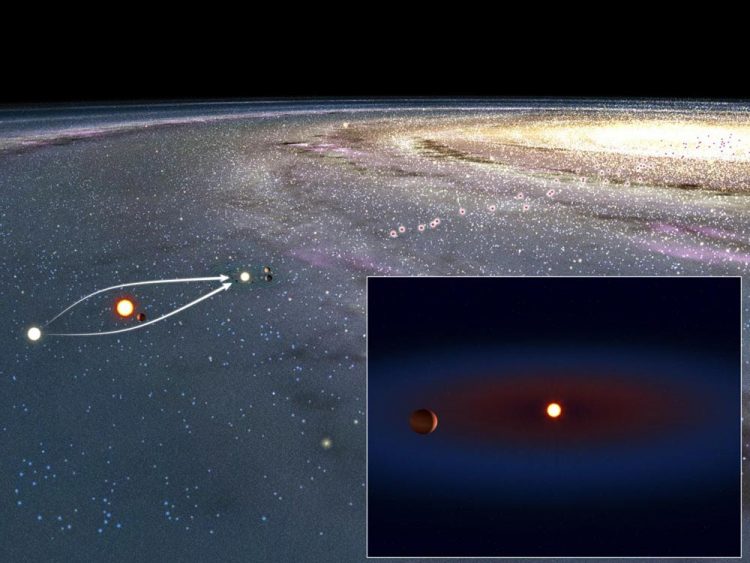Worldwide observations confirm nearby 'lensing' exoplanet

Red dots indicate previous exoplanet systems discovered by microlensing. Inset: Artist's conception of the exoplanet and its host star. Credit: University of Tokyo
On November 1, 2017 amateur astronomer Tadashi Kojima in Gunma Prefecture, Japan reported an enigmatic new object in the constellation Taurus. Astronomers around the world began follow-up observations and determined that this was an example of a rare event known as gravitational microlensing. Einstein's Theory of General Relativity tells us that gravity warps space.
If a foreground object with strong gravity passes directly in front of a background object in outer space this warped space can act as a lens and focus the light from the background object, making it appear to brighten temporarily.
In the case of the object spotted by Kojima, a star 1600 light-years away passed in front of a star 2600 light-years away. Furthermore, by studying the change in the lensed brightness, astronomers determined that the foreground star has a planet orbiting it.
This is not the first time an exoplanet has been discovered by the microlensing technique. But microlensing events are rare and short lived, so the ones discovered so far lie towards the Galactic Center, where stars are the most abundant. In contrast, this exoplanet system was found in almost exactly the opposite direction as observed from the Earth.
One team led by Akihiko Fukui at the University of Tokyo using a collection of 13 telescopes located around the world, including the 188-cm telescope and 91-cm telescope at NAOJ's Okayama Astrophysical Observatory, observed this phenomenon for 76 days and collected enough data to determine the characteristics of the exoplanet system. The host star has a mass about half the mass of the Sun. The exoplanet around it has an orbit similar in size to Earth's orbit, and a mass about 20% heavier than Neptune.
This orbital radius around this type of star coincides with the region where water condenses into ice during the planet formation phase, making this place theoretically favorable for forming gas-giant planets.
Theoretical calculations show that this kind of planet has an a priori detection probability of only 35%. The fact that this exoplanet was discovered by pure chance suggests Neptune-sized planets could be common around this orbital region.
This exoplanet system is closer and brighter as seen from Earth than other exoplanet systems discovered by microlensing. This makes it a prime target for follow-up observations with world-leading telescopes like the Subaru Telescope or next generation extremely large telescopes like the Thirty Meter Telescope TMT.
Media Contact
All latest news from the category: Physics and Astronomy
This area deals with the fundamental laws and building blocks of nature and how they interact, the properties and the behavior of matter, and research into space and time and their structures.
innovations-report provides in-depth reports and articles on subjects such as astrophysics, laser technologies, nuclear, quantum, particle and solid-state physics, nanotechnologies, planetary research and findings (Mars, Venus) and developments related to the Hubble Telescope.
Newest articles

High-energy-density aqueous battery based on halogen multi-electron transfer
Traditional non-aqueous lithium-ion batteries have a high energy density, but their safety is compromised due to the flammable organic electrolytes they utilize. Aqueous batteries use water as the solvent for…

First-ever combined heart pump and pig kidney transplant
…gives new hope to patient with terminal illness. Surgeons at NYU Langone Health performed the first-ever combined mechanical heart pump and gene-edited pig kidney transplant surgery in a 54-year-old woman…

Biophysics: Testing how well biomarkers work
LMU researchers have developed a method to determine how reliably target proteins can be labeled using super-resolution fluorescence microscopy. Modern microscopy techniques make it possible to examine the inner workings…





















